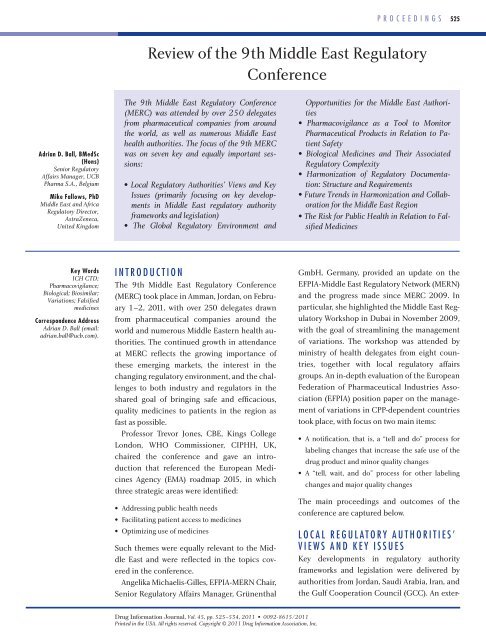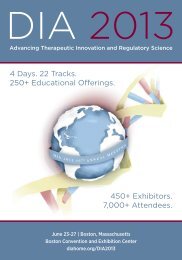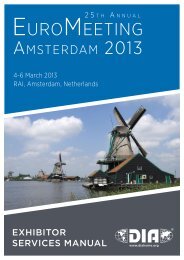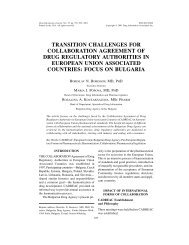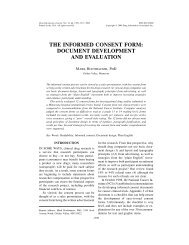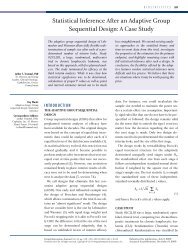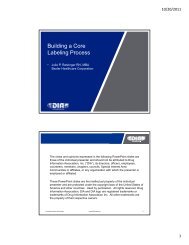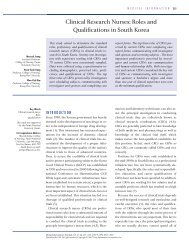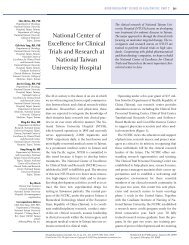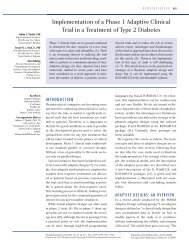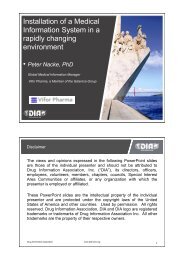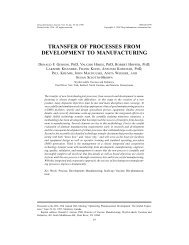Review of the 9th Middle East Regulatory Conference - Drug ...
Review of the 9th Middle East Regulatory Conference - Drug ...
Review of the 9th Middle East Regulatory Conference - Drug ...
You also want an ePaper? Increase the reach of your titles
YUMPU automatically turns print PDFs into web optimized ePapers that Google loves.
Adrian D. Ball, BMedSc<br />
(Hons)<br />
Senior <strong>Regulatory</strong><br />
Affairs Manager, UCB<br />
Pharma S.A., Belgium<br />
Mike Fallows, PhD<br />
<strong>Middle</strong> <strong>East</strong> and Africa<br />
<strong>Regulatory</strong> Director,<br />
AstraZeneca,<br />
United Kingdom<br />
Key Words<br />
ICH CTD;<br />
Pharmacovigilance;<br />
Biological; Biosimilar;<br />
Variations; Falsified<br />
medicines<br />
Correspondence Address<br />
Adrian D. Ball (email:<br />
adrian.ball@ucb.com).<br />
<strong>Review</strong> <strong>of</strong> <strong>the</strong> <strong>9th</strong> <strong>Middle</strong> <strong>East</strong> <strong>Regulatory</strong><br />
<strong>Conference</strong><br />
The <strong>9th</strong> <strong>Middle</strong> <strong>East</strong> <strong>Regulatory</strong> <strong>Conference</strong><br />
(MERC) was attended by over 250 delegates<br />
from pharmaceutical companies from around<br />
<strong>the</strong> world, as well as numerous <strong>Middle</strong> <strong>East</strong><br />
health authorities. The focus <strong>of</strong> <strong>the</strong> <strong>9th</strong> MERC<br />
was on seven key and equally important sessions:<br />
• Local <strong>Regulatory</strong> Authorities’ Views and Key<br />
Issues (primarily focusing on key developments<br />
in <strong>Middle</strong> <strong>East</strong> regulatory authority<br />
frameworks and legislation)<br />
• The Global <strong>Regulatory</strong> Environment and<br />
i n t r o d u c t i o n<br />
The <strong>9th</strong> <strong>Middle</strong> <strong>East</strong> <strong>Regulatory</strong> <strong>Conference</strong><br />
(MERC) took place in Amman, Jordan, on February<br />
1–2, 2011, with over 250 delegates drawn<br />
from pharmaceutical companies around <strong>the</strong><br />
world and numerous <strong>Middle</strong> <strong>East</strong>ern health authorities.<br />
The continued growth in attendance<br />
at MERC reflects <strong>the</strong> growing importance <strong>of</strong><br />
<strong>the</strong>se emerging markets, <strong>the</strong> interest in <strong>the</strong><br />
changing regulatory environment, and <strong>the</strong> challenges<br />
to both industry and regulators in <strong>the</strong><br />
shared goal <strong>of</strong> bringing safe and efficacious,<br />
quality medicines to patients in <strong>the</strong> region as<br />
fast as possible.<br />
Pr<strong>of</strong>essor Trevor Jones, CBE, Kings College<br />
London, WHO Commissioner, CIPHH, UK,<br />
chaired <strong>the</strong> conference and gave an introduction<br />
that referenced <strong>the</strong> European Medicines<br />
Agency (EMA) roadmap 2015, in which<br />
three strategic areas were identified:<br />
• Addressing public health needs<br />
• Facilitating patient access to medicines<br />
• Optimizing use <strong>of</strong> medicines<br />
Such <strong>the</strong>mes were equally relevant to <strong>the</strong> <strong>Middle</strong><br />
<strong>East</strong> and were reflected in <strong>the</strong> topics covered<br />
in <strong>the</strong> conference.<br />
Angelika MichaelisGilles, EFPIAMERN Chair,<br />
Senior <strong>Regulatory</strong> Affairs Manager, Grünenthal<br />
<strong>Drug</strong> Information Journal, Vol. 45, pp. 525–534, 2011 • 0092-8615/2011<br />
Printed in <strong>the</strong> USA. All rights reserved. Copyright © 2011 <strong>Drug</strong> Information Association, Inc.<br />
p r o c e e d i n g s 525<br />
Opportunities for <strong>the</strong> <strong>Middle</strong> <strong>East</strong> Authorities<br />
• Pharmacovigilance as a Tool to Monitor<br />
Pharmaceutical Products in Relation to Patient<br />
Safety<br />
• Biological Medicines and Their Associated<br />
<strong>Regulatory</strong> Complexity<br />
• Harmonization <strong>of</strong> <strong>Regulatory</strong> Documentation:<br />
Structure and Requirements<br />
• Future Trends in Harmonization and Collaboration<br />
for <strong>the</strong> <strong>Middle</strong> <strong>East</strong> Region<br />
• The Risk for Public Health in Relation to Falsified<br />
Medicines<br />
GmbH, Germany, provided an update on <strong>the</strong><br />
EFPIA<strong>Middle</strong> <strong>East</strong> <strong>Regulatory</strong> Network (MERN)<br />
and <strong>the</strong> progress made since MERC 2009. In<br />
particular, she highlighted <strong>the</strong> <strong>Middle</strong> <strong>East</strong> <strong>Regulatory</strong><br />
Workshop in Dubai in November 2009,<br />
with <strong>the</strong> goal <strong>of</strong> streamlining <strong>the</strong> management<br />
<strong>of</strong> variations. The workshop was attended by<br />
ministry <strong>of</strong> health delegates from eight countries,<br />
toge<strong>the</strong>r with local regulatory affairs<br />
groups. An indepth evaluation <strong>of</strong> <strong>the</strong> European<br />
Federation <strong>of</strong> Pharmaceutical Industries Association<br />
(EFPIA) position paper on <strong>the</strong> management<br />
<strong>of</strong> variations in CPPdependent countries<br />
took place, with focus on two main items:<br />
• A notification, that is, a “tell and do” process for<br />
labeling changes that increase <strong>the</strong> safe use <strong>of</strong> <strong>the</strong><br />
drug product and minor quality changes<br />
• A “tell, wait, and do” process for o<strong>the</strong>r labeling<br />
changes and major quality changes<br />
The main proceedings and outcomes <strong>of</strong> <strong>the</strong><br />
conference are captured below.<br />
L o c a L r e g u L at o r y a u t h o r i t i e s ’<br />
V i e w s a n d K e y i s s u e s<br />
Key developments in regulatory authority<br />
frameworks and legislation were delivered by<br />
authorities from Jordan, Saudi Arabia, Iran, and<br />
<strong>the</strong> Gulf Cooperation Council (GCC). An exter
526 p r o c e e d i n g s Ball, Fallows<br />
nal comparison <strong>of</strong> <strong>the</strong> regulatory review process<br />
in <strong>the</strong> GCC was also shared with <strong>the</strong> conference.<br />
Jordan Food and drug<br />
administration<br />
dr Leila Jarrar, drug directorate director,<br />
Jordan Fda, presented <strong>the</strong> JFDA’s structure and<br />
department with focus on <strong>the</strong>ir points <strong>of</strong><br />
strength due to qualified staff, scientific expertise,<br />
openness to regional and international<br />
meeting and exchange, and <strong>the</strong> increase in drug<br />
exports over imports. She spoke in depth about<br />
regulations implemented by <strong>the</strong> JFDA since<br />
MERC 2008, including guidance and legislation<br />
on biosimilar registration, clinical trials,<br />
and pharmacovigilance (JFDA legislation and<br />
guidelines are available on www.jfda.jo). JFDA’s<br />
future visions and targets were to be strategic,<br />
vigilant, quick, and visible, and Dr Jarrar actively<br />
promoted <strong>the</strong> harmonization <strong>of</strong> <strong>the</strong> regulatory<br />
guidelines in <strong>the</strong> region, which are in line<br />
with those <strong>of</strong> ICH.<br />
iranian nationaL drug and Food<br />
Laboratory<br />
dr mahmoud alebouyeh, head <strong>of</strong> <strong>the</strong> biological<br />
Laboratory <strong>of</strong> <strong>the</strong> iranian Food and<br />
drug Control Laboratory, presented new regulations<br />
in Iran for contract manufacturing <strong>of</strong><br />
biopharmaceutical products. These guidelines<br />
are meant to encourage biopharmaceutical<br />
companies to invest in manufacturing facilities<br />
in Iran to produce finished drug products or at<br />
least some aspect <strong>of</strong> drug product manufacture<br />
(96% <strong>of</strong> biopharmaceutical products are<br />
locally manufactured in Iran; all information<br />
is available on www.fdo.ir). He spoke about <strong>the</strong><br />
biosimilar registration process and pointed<br />
out <strong>the</strong> current local manufacture <strong>of</strong> biosimilar<br />
and o<strong>the</strong>r biological products is on <strong>the</strong> increase,<br />
with growing numbers <strong>of</strong> Iranianbased<br />
facilities. The pre and postmarketing surveillance<br />
was <strong>the</strong> last point highlighted by Dr<br />
Alebouyeh when he clarified <strong>the</strong> Iranian pharmacovigilance<br />
system and highlighted <strong>the</strong> in<br />
creasing number <strong>of</strong> adverse drug reports over<br />
<strong>the</strong> years.<br />
saudi arabia Food and<br />
drug authority<br />
dr hajed m. h. hashan, Executive director<br />
<strong>of</strong> Pharmaceutical Products registration department<br />
<strong>of</strong> <strong>the</strong> saudi arabia Food and drug<br />
authority (sFda), outlined <strong>the</strong> vision <strong>of</strong> <strong>the</strong><br />
SFDA to become <strong>the</strong> leading drug regulatory authority<br />
in <strong>the</strong> <strong>Middle</strong> <strong>East</strong>. Dr Hashan informed<br />
<strong>the</strong> conference about <strong>the</strong> progress in <strong>the</strong> SFDA’s<br />
infrastructure, organization, and operational<br />
processes since its inception in 2009 (for fur<strong>the</strong>r<br />
information see www.sfda.gov.sa). Fur<strong>the</strong>rmore,<br />
he pointed out that <strong>the</strong> SFDA has undertaken<br />
fur<strong>the</strong>r internal projects (eg, drug registry<br />
procedure, counterfeit detection, ecoma, LIMS<br />
system, electronic tracking systems), all with <strong>the</strong><br />
goal <strong>of</strong> <strong>the</strong> SFDA’s vision. More detailed guidance<br />
and legislation are being produced by <strong>the</strong><br />
SFDA for biotechnology products. Dr Hashan<br />
highlighted <strong>the</strong> need to harmonize <strong>the</strong> regulatory<br />
environment throughout <strong>the</strong> <strong>Middle</strong> <strong>East</strong><br />
and stressed <strong>the</strong> importance <strong>of</strong> cooperation between<br />
<strong>the</strong> <strong>Middle</strong> <strong>East</strong> regulatory authorities to<br />
streamline regulatory requirements and submission<br />
formats for <strong>the</strong> benefit <strong>of</strong> <strong>the</strong> whole region.<br />
guLF CooPEration CounCiL:<br />
drug rEgistration<br />
dr hajed m. h. hashan, on behalf <strong>of</strong> <strong>the</strong><br />
gCC-dr, gave an overview <strong>of</strong> <strong>the</strong> members, regulatory<br />
initiatives, mission, scope, regulatory<br />
processes, and procedures <strong>of</strong> <strong>the</strong> GCCDR. All<br />
related information can be found at www.sgh<br />
.org.sa. He pointed out that <strong>the</strong> approval timelines<br />
have increased dramatically in <strong>the</strong> past two<br />
years due to limited human resources within <strong>the</strong><br />
GCCDR and that a dramatic increase in regulatory<br />
submissions has occurred, with <strong>the</strong> consequence<br />
being a significant increase in good<br />
manufacturing practice compliance inspections.<br />
a ComParison oF rEguLatory<br />
rEviEw ProCEssEs and thE<br />
FaCtors inFLuEnCing thE QuaLity<br />
oF dECision making in gCC statEs<br />
dr reem al Essa from <strong>the</strong> welsh school <strong>of</strong><br />
Pharmacy, Cardiff university, uk, presented
<strong>9th</strong> <strong>Middle</strong> <strong>East</strong> <strong>Regulatory</strong> <strong>Conference</strong> p r o c e e d i n g s 527<br />
to <strong>the</strong> conference her study, comparing regulatory<br />
review processes and factors influencing<br />
decision making in <strong>the</strong> GCC. The study focuses<br />
on regulatory affairs processes and <strong>the</strong> measures<br />
used to build quality into <strong>the</strong> regulatory<br />
review process, and how this improves decisionmaking<br />
processes in GCC regulatory authorities.<br />
From Dr Essa’s findings, her conclusions<br />
were that <strong>the</strong> majority <strong>of</strong> GCC authorities<br />
should deploy some form <strong>of</strong> training and continuous<br />
education programs for <strong>the</strong>ir reviewing<br />
staff, that joint reviews, as part <strong>of</strong> <strong>the</strong> GCCDR<br />
system, should take place, and that a wide range<br />
<strong>of</strong> activities should occur to improve communication<br />
with <strong>the</strong> pharmaceutical industry and<br />
transparency with <strong>the</strong> public.<br />
Her key recommendations were adoption <strong>of</strong><br />
a standardized regulatory assessment template<br />
and parallel assessment <strong>of</strong> sample analysis and<br />
pricing with <strong>the</strong> scientific assessment process<br />
to improve patients’ access time, engagement <strong>of</strong><br />
external quality audits by accredited external<br />
certification bodies, and improvement <strong>of</strong> transparency<br />
to increase confidence in <strong>the</strong>ir review<br />
practices.<br />
g L o b a L r e g u L at o r y<br />
e n V i r o n m e n t a n d o p p o r t u n i t i e s<br />
f o r t h e m i d d L e e a s t<br />
This session was to raise awareness <strong>of</strong> <strong>the</strong> global<br />
regulatory environment outside <strong>the</strong> <strong>Middle</strong><br />
<strong>East</strong> and to present an overview <strong>of</strong> its impact on<br />
local <strong>Middle</strong> <strong>East</strong>ern regulatory authorities.<br />
Presentations from both aspects were given<br />
with key recommendations in variation management<br />
for consideration in <strong>the</strong> future.<br />
variation managEmEnt and FuturE<br />
trEnds in thE Eu<br />
dr Christa wirthumer-hoche, head <strong>of</strong> marketing<br />
authorization <strong>of</strong> medicinal Products<br />
and Lifecycle management, agEs Pharmmed,<br />
austria, presented <strong>the</strong> new EU variation<br />
guidelines that came into force at <strong>the</strong> beginning<br />
<strong>of</strong> 2010. This included <strong>the</strong> different classification<br />
<strong>of</strong> changes, that is, Type IA (minor variations),<br />
Type II (major changes), and Type IB (by<br />
<strong>Drug</strong> Information Journal<br />
default, ie, nei<strong>the</strong>r a Type IA or II nor an extension).<br />
The objective was to introduce simpler and<br />
more flexible guidelines to reduce <strong>the</strong> administrative<br />
burden for both <strong>the</strong> industry and <strong>the</strong> authorities.<br />
This new variation guideline covers changes<br />
to all EU procedures (centralized, mutual recognition,<br />
decentralized, national) and is applicable<br />
to both human and veterinary products.<br />
The guidelines are published on <strong>the</strong> DG<br />
Health website (EC 1234/2008) and should be<br />
referred to for a better understanding <strong>of</strong> <strong>the</strong><br />
classification <strong>of</strong> <strong>the</strong> different variations and <strong>the</strong><br />
regulatory conditions to be fulfilled.<br />
variation managEmEnt in thE middLE<br />
<strong>East</strong>: LoCaL ExPEriEnCEs<br />
dr ramy behbehani, a registration and release<br />
superintendent from <strong>the</strong> kuwait Food<br />
and drug Control administration (kFdC),<br />
started by providing a definition <strong>of</strong> a variation<br />
and <strong>the</strong> need for a change in <strong>the</strong> requirements<br />
to protect public health by better use <strong>of</strong> medicines.<br />
Enabling faster implementation <strong>of</strong> scientific<br />
progress for <strong>the</strong> benefit <strong>of</strong> patients should<br />
be industry and regulators’ goal.<br />
He explained how variations are currently<br />
managed in Kuwait, referencing Guidelines Decree<br />
302/80 (recently amended by adding annex<br />
no. 7), which categorized each variation according<br />
to its type and also provided a list <strong>of</strong><br />
regulatory requirements to be submitted for <strong>the</strong><br />
change. The categories <strong>of</strong> <strong>the</strong> variations were in<br />
line with those adopted by o<strong>the</strong>r competent<br />
<strong>Middle</strong> <strong>East</strong> regulatory authorities.<br />
In terms <strong>of</strong> approvals, according to <strong>the</strong> current<br />
guidelines, <strong>the</strong> market authorization holder<br />
should wait for approval from <strong>the</strong> KFDC before<br />
implementing <strong>the</strong> proposed changes. His<br />
proposal for <strong>the</strong> conference to consider, in line<br />
with EU variation guidelines (tell and do, tell,<br />
wait and do process) and <strong>the</strong> EFPIA position paper<br />
on <strong>the</strong> management <strong>of</strong> variation, was to harmonize<br />
with <strong>the</strong> EU regulations so as to avoid<br />
duplication, simplify regulatory review, and<br />
speed up <strong>the</strong> approval process.
528 p r o c e e d i n g s Ball, Fallows<br />
p r e - a n d p o s t m a r K e t i n g<br />
s a f e t y a n d p h a r m a c o V i g i L a n c e<br />
a s a t o o L t o m o n i t o r<br />
p h a r m a c e u t i c a L p r o d u c t s<br />
This session’s subject matter was to discuss tools<br />
that contribute to <strong>the</strong> continual monitoring <strong>of</strong><br />
pharmaceutical products in relation to patient<br />
safety. This provided significant debate during<br />
<strong>the</strong> conference as both industry and regulatory<br />
authorities prioritize patient safety as key in<br />
pharmaceutical development.<br />
sFda PharmaCovigiLanCE uPdatE<br />
dr ghazi s. saeed, director <strong>of</strong> Pharmacovigilance<br />
department, sFda, saudi arabia,<br />
highlighted that establishing a postmarketing<br />
surveillance program is a strategic imperative to<br />
contribute to <strong>the</strong> protection <strong>of</strong> public health.<br />
This can be achieved by monitoring <strong>the</strong> safety<br />
and quality <strong>of</strong> medicines and by ensuring access<br />
to uptodate safety information on medicines<br />
to patients and health providers. During<br />
his presentation, Dr Saeed gave an overview <strong>of</strong><br />
SFDA achievements and a summary <strong>of</strong> <strong>the</strong> reporting<br />
process and tools.<br />
Besides <strong>the</strong> National Pharmacovigilance<br />
Center (NPC) creation (which has been operational<br />
since March 2009), awareness measures<br />
were taken to improve <strong>the</strong> reporting culture,<br />
and guidelines were issued for pharmacovigilance<br />
obligations and reporting. One <strong>of</strong> <strong>the</strong><br />
strategies for making <strong>the</strong> reporting plan successful<br />
is <strong>the</strong> organization <strong>of</strong> pharmacovigilance<br />
campaigns, and so far 37 workshops have<br />
been held and more than 4,000 health care<br />
pr<strong>of</strong>essionals trained in adverse drug reactions<br />
(ADRs) and reporting across <strong>the</strong> country with<br />
<strong>the</strong> help <strong>of</strong> 62 coordinators from major hospitals.<br />
Dr Saeed illustrated <strong>the</strong> reporting figures,<br />
since <strong>the</strong> deployment <strong>of</strong> NPC, consisting <strong>of</strong> serious<br />
events.<br />
Dr Saeed went on to explain <strong>the</strong> role <strong>of</strong> <strong>the</strong><br />
pharmacovigilance department’s advisory committee.<br />
The committee’s main responsibilities<br />
are assessing signal detection, periodic safety<br />
update reports, and implementing consequential<br />
actions on labeling to revoke marketing au<br />
thorizations based on safety concerns. The success<br />
<strong>of</strong> this committee is due to its regular<br />
meetings and <strong>the</strong> extensive training <strong>of</strong> <strong>the</strong> department’s<br />
staff.<br />
Dr Saeed concluded that tackling <strong>the</strong> underreporting<br />
<strong>of</strong> ADRs is imperative and continuing<br />
efforts in safety monitoring will contribute to<br />
<strong>the</strong> future safety <strong>of</strong> patients.<br />
PharmaCovigiLanCE: rEviEw<br />
oF intErnationaL aPProaChEs<br />
and trEnds<br />
sten olsson, Chief who Programme <strong>of</strong>ficer,<br />
uppsala monitoring Centre, who Collaborating<br />
Centre for international drug monitoring,<br />
sweden, introduced his presentation<br />
by reminding <strong>the</strong> audience that pharmacovigilance<br />
covers adverse effects but also product<br />
quality, inadequate use, and safety challenges <strong>of</strong><br />
mass treatment campaigns. He pointed out that<br />
spontaneous reporting is <strong>the</strong> backbone <strong>of</strong> any<br />
pharmacovigilance system and <strong>the</strong> value for<br />
having collected data over <strong>the</strong> world. In <strong>the</strong> last<br />
15 years <strong>the</strong> number <strong>of</strong> member countries <strong>of</strong><br />
<strong>the</strong> WHO program for international drug monitoring<br />
has more than doubled (104 including<br />
Oman, Iran, Egypt, Jordan, Saudi Arabia, and<br />
Iraq), allowing a significant growth <strong>of</strong> <strong>the</strong> WHO<br />
database (VigiBase, storing around 6,000,000<br />
individual safety case reports), but <strong>the</strong> ongoing<br />
challenge is to expand member countries and<br />
reporting.<br />
Mr Olsson detailed <strong>the</strong> different national system<br />
approaches, in terms <strong>of</strong> organization, affiliation,<br />
and regulation. VigiBase allows comparisons<br />
in terms <strong>of</strong> rate <strong>of</strong> reporting to be made.<br />
Despite some <strong>Middle</strong> <strong>East</strong> countries having a<br />
more dynamic reporting rate, it is unfortunate<br />
that <strong>the</strong> overall rate remains low compared to<br />
global trends, and <strong>the</strong> frequency <strong>of</strong> reporting to<br />
VigiBase needs to increase across <strong>the</strong> <strong>Middle</strong><br />
<strong>East</strong> region.<br />
In conclusion, having functional pharmacovigilance<br />
systems becomes a necessity with <strong>the</strong><br />
increase <strong>of</strong> global access to medicines and is<br />
supported by global health initiatives and<br />
WHO. Mr Olsson informed <strong>the</strong> conference that
<strong>9th</strong> <strong>Middle</strong> <strong>East</strong> <strong>Regulatory</strong> <strong>Conference</strong> p r o c e e d i n g s 529<br />
as part <strong>of</strong> a joint WHO/Global Fund strategy, facilitating<br />
documents have been made available,<br />
and WHO is committed to providing relevant<br />
services to all countries. The demand for training<br />
remains a bottleneck where capacity scaleup<br />
is needed.<br />
t h e r o L e o f r e s e a r c h a n d<br />
d e V e L o p m e n t i n pat i e n t<br />
a c c e s s t o n e w m e d i c i n e s<br />
The <strong>the</strong>me <strong>of</strong> this subject was to explore biological<br />
medicines and <strong>the</strong>ir associated regulatory<br />
complexity. Speakers from industry and regulatory<br />
authorities gave compelling presentations<br />
on biological and biosimilar products.<br />
biosimiLar guidanCE:<br />
Luxury or nECEssity<br />
dr thomas schreitmueller, head, regulatory<br />
Policy and strategy biologics, h<strong>of</strong>fmann La<br />
roche Ltd, basel, switzerland, explained that<br />
biologics are large and very complex molecules<br />
and that <strong>the</strong>ir manufacturing process confers<br />
unique properties that make <strong>the</strong>m not identical<br />
to <strong>the</strong> original molecule. He shared examples <strong>of</strong><br />
modifications that can take place with biologics<br />
(deamidation, glycation, sialylation, methionine<br />
oxidation, etc) inherent or due to <strong>the</strong> manufacturing<br />
process, which may result in approximately<br />
10 8 potential variants. Dr Schreitmueller<br />
explained that manufacturers <strong>of</strong> biological<br />
products must comply with an extensive set <strong>of</strong><br />
regulations and guidance documents to ensure<br />
quality and safety <strong>of</strong> biological products, giving<br />
<strong>the</strong> US FDA, EMA, and ICH as examples. The<br />
speaker concluded that all biosimilars must undergo<br />
stepwise and headtohead comparisons,<br />
including comparative quality, nonclinical, and<br />
clinical studies to <strong>the</strong> same reference requested.<br />
He informed <strong>the</strong> conference that if major differences<br />
are found in <strong>the</strong> quality, nonclinical, and<br />
clinical studies, <strong>the</strong> product should not be considered<br />
similar and, <strong>the</strong>refore, o<strong>the</strong>r options for<br />
its fur<strong>the</strong>r development should be considered<br />
(eg, full development). Dr Schreit mueller shared<br />
that countries adopting EMA or WHO guidance<br />
will have robust biosimilar approval pathways.<br />
<strong>Drug</strong> Information Journal<br />
biosimiLar mEdiCinaL ProduCts:<br />
Eu ExPEriEnCE and PErsPECtivEs<br />
Pr Jean-hugues trouvin, bwP Chair, Ema,<br />
and scientific advisor for biological/biotech<br />
products, aFssaPs, France, highlighted <strong>the</strong><br />
regulatory framework fact that in <strong>the</strong> 2000s,<br />
many marketing authorizations <strong>of</strong> biological<br />
products expired (hGh, EPO, GCSF, etc) and<br />
<strong>the</strong> regulators were obliged to elaborate a status<br />
<strong>of</strong> biosimilars in Europe. This was because biologicals<br />
are complex at molecular levels and<br />
characterization and quality controls are complex<br />
as a consequence. Therefore <strong>the</strong> bioequivalence<br />
parameters used for assessing generics<br />
are not sufficient and relevant for biologicals.<br />
In Europe, <strong>the</strong> legal framework for biosimilars<br />
was introduced in 2003. Guidelines for quality,<br />
nonclinical, and clinical studies to accompany<br />
biosimilar status were presented. Pr Trouvin focused<br />
his presentation on <strong>the</strong> biosimilar concept<br />
and <strong>the</strong> comparability exercise.<br />
In conclusion, biosimilar does not mean generic.<br />
“Bio” means that this is a biological product,<br />
with all its complexity and consequences in<br />
terms <strong>of</strong> safety and efficacy. It is not recommended<br />
to switch patients from one biological<br />
product to ano<strong>the</strong>r without <strong>the</strong>rapeutic justification.<br />
The biosimilarity concept as well as <strong>the</strong><br />
comparability program are not aimed at concluding<br />
that <strong>the</strong> two products are identical.<br />
“Similar” indicates <strong>the</strong> product’s administrative<br />
and regulatory status.<br />
sPECiFiCitiEs oF thE<br />
dEvELoPmEnt and rEgistration<br />
oF biosimiLars in EuroPE<br />
dr david uguen, Executive director <strong>of</strong> voisin<br />
Consulting Life sciences, France, focused his<br />
presentation on <strong>the</strong> biosimilar dossier content<br />
and <strong>the</strong> differences that may occur between <strong>the</strong><br />
reference biological product and <strong>the</strong> biosimilar.<br />
Several biosimilar products are registered and<br />
marketed in Europe, and many more will come.<br />
A biosimilar is a biological product, similar to a<br />
reference biological medicinal product, is not a<br />
generic medicinal product, and requires <strong>the</strong><br />
conduct <strong>of</strong> nonclinical and clinical studies be
530 p r o c e e d i n g s Ball, Fallows<br />
fore registration. The reference biological product<br />
must be authorized in <strong>the</strong> EU on <strong>the</strong> basis<br />
<strong>of</strong> a complete dossier, used as reference<br />
throughout <strong>the</strong> full development (quality, safety,<br />
and efficacy) <strong>of</strong> <strong>the</strong> biosimilar, to allow generation<br />
<strong>of</strong> coherent data and conclusions, at <strong>the</strong><br />
time <strong>of</strong> launch <strong>of</strong> <strong>the</strong> biosimilar.<br />
A biosimilar is not a generic because biologicals<br />
are more complex than chemical products<br />
and <strong>the</strong>refore more difficult to fully characterize.<br />
Subtle differences between biosimilars may<br />
not be apparent with today’s analytical methods.<br />
These subtle differences may be due to differences<br />
in raw materials or manufacturing processes<br />
and may relate to structural differences<br />
in <strong>the</strong> active substance or impurity pr<strong>of</strong>iles.<br />
These have an important impact on safety or efficacy<br />
and hence <strong>the</strong> need for nonclinical and<br />
clinical studies to be conducted.<br />
Dr Uguen’s takehome message was that biosimilar<br />
product development and dossiers are<br />
complex and as a consequence, comparative trials<br />
must be conducted to demonstrate similarity<br />
to <strong>the</strong> reference biological medicinal product.<br />
h a r m o n i Z at i o n o f<br />
d o c u m e n tat i o n f o r<br />
m a r K e t a c c e s s<br />
Moving on from MERC 8, this session presented<br />
an opportunity for discussion and feedback<br />
on how <strong>the</strong> <strong>Middle</strong> <strong>East</strong> regulatory authorities<br />
had progressed toward a harmonized ICHCTD<br />
structure and an opportunity for industry to<br />
present its perspective, with significant debate<br />
and collaboration.<br />
Ctd/E-Ctd: an Eu rEguLatory<br />
authority PErsPECtivE<br />
dr Christa wirthumer-hoche, agEs Pharmmed,<br />
vienna, austria, highlighted that <strong>the</strong><br />
Common Technical Document (CTD) provides<br />
a common format and not necessarily common<br />
content and explained that until now CTD has<br />
been mandatory in <strong>the</strong> EU and eCTD is recommended<br />
and not yet mandatory, except in <strong>the</strong><br />
case <strong>of</strong> esubmission. She spoke about an ongoing<br />
process to improve and develop a new major<br />
version <strong>of</strong> <strong>the</strong> eCTD including an eapplication<br />
form, product information management, and<br />
<strong>the</strong> perspective <strong>of</strong> <strong>the</strong> European agencies to<br />
have a European submission and tracking system<br />
via twoway electronic communication with<br />
<strong>the</strong> industry.<br />
sFda: ChaLLEngEs<br />
and LEssons LEarnEd<br />
hassaan al wohaibi, regulatory affairs manager<br />
at <strong>the</strong> sFda, saudi arabia, gave an overview<br />
<strong>of</strong> <strong>the</strong> experience <strong>of</strong> <strong>the</strong> SFDA in establishing<br />
its structure and organization from 2003<br />
until it become an operating organization in<br />
2009. He highlighted <strong>the</strong> challenges it faced in<br />
terms <strong>of</strong> infrastructure, processes, guidelines,<br />
and eservices. He presented statistics relating<br />
to SFDA regulatory submission meetings in<br />
2010; only 55% <strong>of</strong> sponsors attended preorganized<br />
regulatory submission meetings, and in<br />
most cases <strong>the</strong> SFDA had not received prior notice<br />
<strong>of</strong> cancellation. This was deemed by <strong>the</strong> entire<br />
conference an area for radical improvement.<br />
The presentation also discussed <strong>the</strong> CTD<br />
structure as a new concept, with reviewers requiring<br />
more experience, and concluded with<br />
<strong>the</strong> necessity <strong>of</strong> training in all aspects <strong>of</strong> dossier<br />
review and assessment.<br />
Ctd and E-Ctd submission<br />
rebekah Logan, director <strong>of</strong> regulatory affairs,<br />
Eli Lilly, usa, informed <strong>the</strong> audience<br />
that <strong>the</strong> CTD is a useful standard for formatting<br />
drug registration documentation. The speaker<br />
encouraged simple electronic submission standards<br />
(NeeS) to reduce use <strong>of</strong> resources. Ms Logan<br />
stated that while using CTD, compliance<br />
with <strong>the</strong> ICH definition <strong>of</strong> CTD is critical and<br />
only <strong>the</strong>n can using CTD benefit <strong>the</strong> industry,<br />
agencies, and patients.<br />
She encouraged agencies to minimize <strong>the</strong>ir<br />
expectations for requesting customized countryspecific<br />
documentation beyond <strong>the</strong> ICH<br />
CTD content and that instead could rely on<br />
source country approvals as an additional<br />
source for information and/or on manufacturing<br />
site inspections. Ms Logan provided examples<br />
<strong>of</strong> countryspecific requests that are not
<strong>9th</strong> <strong>Middle</strong> <strong>East</strong> <strong>Regulatory</strong> <strong>Conference</strong> p r o c e e d i n g s 531<br />
aligned with <strong>the</strong> ICH CTD content and suggested<br />
removal from regulatory requirements <strong>of</strong><br />
signed and stamped specification documents<br />
from <strong>the</strong> manufacturer; validation <strong>of</strong> analytical<br />
procedures; request for assays <strong>of</strong> API and degradation<br />
products, especially with raw data and<br />
chromatograms; container closure system description<br />
<strong>of</strong> packaging material; raw stability<br />
data; chromatograms; and inuse stability information.<br />
In conclusion, harmonization to ICH CTD<br />
structure for pharmaceutical regulatory dossiers<br />
is encouraged, and authorities within <strong>the</strong><br />
<strong>Middle</strong> <strong>East</strong> region are on <strong>the</strong> path to being<br />
successful in this.<br />
t h e c h a n g i n g<br />
r e g u L at o r y e n V i r o n m e n t<br />
Following on from discussions <strong>of</strong> <strong>the</strong> structure<br />
<strong>of</strong> a regulatory dossier, discussing <strong>the</strong> changing<br />
regulatory environment provided <strong>the</strong> conference<br />
with a medium to reflect on <strong>the</strong> progress<br />
<strong>of</strong> <strong>the</strong> <strong>Middle</strong> <strong>East</strong> region in relation to harmonization,<br />
legislation, and operating principles<br />
and to look toward <strong>the</strong> future regulatory environment.<br />
rEguLatory CooPEration<br />
and harmonization: bEnEFits<br />
to PubLiC hEaLth<br />
dr Lembit rägo, Coordinator, Quality assurance<br />
and safety: medicines, department <strong>of</strong><br />
Essential medicines and Pharmaceutical<br />
Policies, who, switzerland, gave a comprehensive<br />
review <strong>of</strong> <strong>the</strong> evolution and shifts in <strong>the</strong><br />
regulatory paradigms giving focus to <strong>the</strong> importance,<br />
and growing need, <strong>of</strong> increased harmonization<br />
among regulators. He commented that<br />
<strong>the</strong> environment in which regulators operate<br />
continues to change, with <strong>the</strong> development <strong>of</strong><br />
new technologies and globalization <strong>of</strong> R&D and<br />
<strong>the</strong> economic landscape as some <strong>of</strong> <strong>the</strong> examples<br />
given. Dr Rägo suggested that regulators<br />
should, through harmonization, focus on areas<br />
and activities where <strong>the</strong>y can add value and<br />
best contribute to public health. Through <strong>the</strong><br />
formation <strong>of</strong> effective networks between regulatory<br />
authorities <strong>the</strong> sharing <strong>of</strong> scarce resources<br />
<strong>Drug</strong> Information Journal<br />
and elimination <strong>of</strong> duplicate activities could be<br />
facilitated. His presentation highlighted <strong>the</strong><br />
harmonization and collaboration initiatives<br />
WHO supports, such as being a partner in <strong>the</strong><br />
WPRO initiative and WPRO support for harmonization<br />
in ASEAN.<br />
rEguLatory work sharing<br />
in thE middLE <strong>East</strong><br />
dr hajed hashan, Executive director <strong>of</strong><br />
Pharmaceutical Products registration department,<br />
sFda, saudi arabia, spoke on how<br />
he saw <strong>the</strong> region could fur<strong>the</strong>r improve and<br />
share ideas going forward. Dr Hashan acknowledged<br />
<strong>the</strong> key elements <strong>of</strong> change that have occurred<br />
over <strong>the</strong> period <strong>of</strong> <strong>the</strong> last nine MERCs<br />
and how <strong>the</strong> environment has evolved. Looking<br />
forward, he identified areas that <strong>of</strong>fered fur<strong>the</strong>r<br />
opportunity for sharing:<br />
• Harmonization<br />
• Research<br />
• Training<br />
• Transparency<br />
• Cooperation between regulatory authorities on a<br />
global level<br />
During <strong>the</strong> discussion, Dr Hashan commented<br />
that it was important to understand that collaboration<br />
does not mean a decrease in resources.<br />
Before consolidating, <strong>the</strong>re is a need to<br />
ensure that <strong>the</strong>re are enough resources to progress<br />
and maintain collaboration. In addition,<br />
collaboration should not be viewed as a reflection<br />
on an inability to do it yourself but an opportunity<br />
to learn and avoid duplication.<br />
fa L s i f i e d m e d i c i n e s<br />
This subject area’s key goal was to emphasize<br />
and continue to reduce <strong>the</strong> public health risk<br />
posed by falsified medicines. The interaction<br />
between regulatory authorities and industry is<br />
key in targeting this goal <strong>of</strong> eradicating falsified<br />
medicines. This again provided significant debate<br />
during <strong>the</strong> conference. Four speakers were<br />
invited to share <strong>the</strong>ir views and experiences on<br />
this matter: dr Lembit rägo (Coordinator,<br />
Quality Assurance and Safety: Medicines, Department<br />
<strong>of</strong> Essential Medicines and Pharma
532 p r o c e e d i n g s Ball, Fallows<br />
ceutical Policies, WHO, Switzerland), dr Colette<br />
raidy (Head <strong>of</strong> Inspection Department,<br />
Ministry <strong>of</strong> Health, Lebanon), dr ziad nassour<br />
(President <strong>of</strong> <strong>the</strong> Lebanese Order <strong>of</strong><br />
Pharmacists, President <strong>of</strong> EMROPHARM<br />
Forum, WHO, Vice President <strong>of</strong> CIOPF, Lebanon),<br />
and tracy hassan (Director, Global<br />
Brand Protection, <strong>the</strong> Pharmaceutical Companies<br />
<strong>of</strong> Johnson and Johnson, USA). All speakers<br />
emphasized that falsified medicines are a<br />
growing problem that affects all regions in our<br />
world and that <strong>the</strong>re is a need to continue risk<br />
minimization for public health.<br />
The team <strong>of</strong> Quality Assurance and Safety <strong>of</strong><br />
Medicines in <strong>the</strong> department <strong>of</strong> Essential Medicines<br />
and Pharmaceutical Policies <strong>of</strong> <strong>the</strong> cluster<br />
<strong>of</strong> Health Systems and Services located at WHO<br />
includes also <strong>the</strong> program for anticounterfeiting<br />
under <strong>the</strong> lead <strong>of</strong> Dr Sabine Kopp, who is<br />
also executive secretary <strong>of</strong> <strong>the</strong> International<br />
Medicinal Products Anticounterfeiting Taskforce,<br />
which is hosted by <strong>the</strong> government <strong>of</strong> Italy.<br />
According to Dr Rägo, <strong>the</strong> anticounterfeiting<br />
program includes recommendations, policy advice,<br />
and training to improve quality and transparency<br />
<strong>of</strong> regulatory activities to enable a<br />
more accurate survey <strong>of</strong> products to be placed<br />
on <strong>the</strong> markets by developing global activities<br />
to combat substandard and falsified medicines.<br />
During 2008 and 2009, concerns arose that<br />
<strong>the</strong> fight against counterfeit or falsified medicines<br />
might have negative impact on generics,<br />
and <strong>the</strong> use <strong>of</strong> <strong>the</strong> counterfeit argument for limiting<br />
free trade, competition, and parallel trade<br />
as well as <strong>the</strong> use <strong>of</strong> <strong>the</strong> term “counterfeit medicinal<br />
product” in patents led to disputes due<br />
to a lack <strong>of</strong> agreement. The proposal is to<br />
change <strong>the</strong> definition from counterfeit to falsified,<br />
which is a more distinct expression for <strong>the</strong><br />
crime committed against human health (for fur<strong>the</strong>r<br />
information see http://www.who.int/medi<br />
cines/services/counterfeit/eu/).<br />
Also according to Dr Raidy, <strong>the</strong> counterfeit or<br />
falsified products are a major public health risk<br />
for all communities, and she emphasized that<br />
<strong>the</strong> known counterfeit or falsified products<br />
market amounts to at least $75–200 billion per<br />
year and that <strong>the</strong> situation is expected to get<br />
worse. The production and sale <strong>of</strong> counterfeit<br />
or falsified products is on <strong>the</strong> rise, not only in<br />
<strong>the</strong> developing countries, which are facing <strong>the</strong><br />
worst problem, but also in developed countries.<br />
In this context it needs to be considered that<br />
unwary consumers are buying counterfeit or<br />
falsified products over <strong>the</strong> Internet. According<br />
to WHO, more than 50% <strong>of</strong> <strong>the</strong> medicine<br />
bought from certain illegal websites has been<br />
found to be fake. Not only cheaper prices but<br />
also lack <strong>of</strong> education and awareness <strong>of</strong> danger<br />
on <strong>the</strong> part <strong>of</strong> <strong>the</strong> consumers support this increasing<br />
market. She emphasized that <strong>the</strong> circulation<br />
<strong>of</strong> counterfeit or falsified products is<br />
difficult to stop, and she presented tools, guidelines,<br />
and activities <strong>of</strong> regulators in Lebanon,<br />
including cooperation and collaboration between<br />
ministries <strong>of</strong> health, customs, and police,<br />
to combat this increasing trade.<br />
Counterfeit or falsified products are silent<br />
killers distributed by criminals, Dr Nassour<br />
said, and he presented alarming results <strong>of</strong> falsification<br />
<strong>of</strong> medicines, which <strong>of</strong>ten cannot be<br />
detected without diligent laboratory examination,<br />
and which can cause severe damage to<br />
public health. He mentioned that <strong>the</strong>re is a major<br />
conflict between <strong>the</strong> culture <strong>of</strong> pr<strong>of</strong>essionals<br />
who are responsible for public health and <strong>the</strong><br />
culture <strong>of</strong> traders, based on greed and pr<strong>of</strong>it,<br />
supply, and demand as well as on promotion<br />
and consumption. As a measure to enhance<br />
awareness <strong>of</strong> <strong>the</strong> customs, institutions, health<br />
pr<strong>of</strong>essionals, pharmacists, distributors, and<br />
consumers against counterfeit or falsified medicines,<br />
he and his associates started a great campaign<br />
all over Lebanon. In summary, Dr Nassour<br />
encourages more serious sanctions against<br />
counterfeiting, an active coordination with <strong>the</strong><br />
international authorities (FDA, EMEA, WHO,<br />
etc), and also a political commitment and a real<br />
will <strong>of</strong> world governments to fight counterfeiting.<br />
First <strong>of</strong> all patient safety, but also <strong>the</strong> reputation<br />
<strong>of</strong> <strong>the</strong> product and brand as well as <strong>the</strong><br />
manufacturer are endangered by <strong>the</strong> market for<br />
counterfeit or falsified products. According to
<strong>9th</strong> <strong>Middle</strong> <strong>East</strong> <strong>Regulatory</strong> <strong>Conference</strong> p r o c e e d i n g s 533<br />
Tracy Hassan, it is definitely also <strong>the</strong> aim <strong>of</strong> industry<br />
to use product protection technology, to<br />
improve <strong>the</strong> safety and transparency <strong>of</strong> <strong>the</strong> supply<br />
chain, to participate in governmental and<br />
industry initiatives, and to manage issues as<br />
<strong>the</strong>y arise. She explained that safe and secure<br />
supply chain practices in industry are one <strong>of</strong><br />
<strong>the</strong> steps industry can use to fight against a<br />
counterfeit or falsified products market: prompt<br />
incident reporting and management, monitoring<br />
to identify issues, internally available commercial<br />
data awareness, distributor compliance,<br />
and proper transportation and facility security<br />
as well as anticounterfeit product protection by<br />
security holograms, labels, stickers, and fur<strong>the</strong>r<br />
antitampering measures.<br />
All speakers emphasized that immediate measures<br />
by manufacturers, customs, distributors,<br />
institutions, pharmacists, health pr<strong>of</strong>essionals,<br />
and consumers as well as security agencies are<br />
urgently needed to carry on <strong>the</strong> fight against<br />
<strong>the</strong> increasing market for falsified products. In<br />
addition, all speakers agreed that suitable education<br />
for an increased awareness <strong>of</strong> <strong>the</strong> public<br />
worldwide is a mandatory step for improvement<br />
<strong>of</strong> <strong>the</strong> situation.<br />
s u m m a r y a n d w ay s f o r w a r d<br />
Some key topics emerged from <strong>the</strong> conference<br />
program and <strong>the</strong> panel debates, which warrant<br />
fur<strong>the</strong>r consideration by industry and regulators,<br />
ei<strong>the</strong>r through discussions at a local level<br />
through <strong>the</strong> industry associations or through<br />
<strong>the</strong> development <strong>of</strong> <strong>the</strong> <strong>Middle</strong> <strong>East</strong> <strong>Regulatory</strong><br />
Workshop in 2012:<br />
• ICH CTD: GCC member countries have implemented<br />
CTD and <strong>the</strong> Arab League has committed<br />
to implementation by <strong>the</strong> end <strong>of</strong> 2013, although<br />
<strong>the</strong> legal status <strong>of</strong> this decision is unclear. This <strong>of</strong>fers<br />
<strong>the</strong> opportunity for harmonization across <strong>the</strong><br />
region, not only in format but also in content <strong>of</strong><br />
<strong>Drug</strong> Information Journal<br />
dossiers for new products. There is also <strong>the</strong> need to<br />
consider older products, where focus on upgrading<br />
Module 3 may be <strong>the</strong> most pragmatic solution.<br />
• Pharmacovigilance: legislation and systems have<br />
been introduced in some markets in <strong>the</strong> region,<br />
with a number <strong>of</strong> consequential requirements on<br />
companies. Clarifying some confusion over <strong>the</strong><br />
definition <strong>of</strong> a market authorization holder will<br />
help companies discharge <strong>the</strong>ir responsibilities relating<br />
to pharmacovigilance.<br />
• Variations: <strong>the</strong> adoption <strong>of</strong> <strong>the</strong> EU guidelines, including<br />
<strong>the</strong> latest simplifications to reduce administrative<br />
burden on authorities, is also a topic worthy<br />
<strong>of</strong> fur<strong>the</strong>r debate. Classification <strong>of</strong> different<br />
types <strong>of</strong> change is key and could form <strong>the</strong> basis <strong>of</strong> a<br />
training workshop.<br />
During <strong>the</strong> conference, <strong>the</strong> challenge faced by<br />
authorities on what to do with limited resources<br />
became apparent. The decisions taken now on<br />
prioritization will potentially impact future regulatory<br />
environment in <strong>the</strong> region. Pr<strong>of</strong>essor<br />
Jones encouraged continued dialogue between<br />
industry and regulatory authorities to progress<br />
<strong>the</strong> debate and take action to fur<strong>the</strong>r improve<br />
access to safe and efficacious, quality medicines<br />
to patients in <strong>the</strong> region.<br />
Acknowledgments—The authors express sincere<br />
thanks to <strong>the</strong> following individuals for <strong>the</strong>ir contribution<br />
in preparing this article, namely: Angelika<br />
MichaelisGilles, EFPIAMERN Chair, Grünenthal<br />
GmbH, Germany; Kerstin AhrendtSölter, MERN<br />
member, Biotest AG, Germany; Sheherazad Aftabroushad,<br />
MERN member, Eli Lilly, Switzerland; Visda<br />
Vaghayenegar, MERN member, San<strong>of</strong>iAventis,<br />
France; Amanda Foster, MERN member, GlaxoSmith<br />
Kline, UK; MohamedRafik Nurmohamed, MERN<br />
member, Biogen Idec, UK; Nadine Otin, MERN member,<br />
Cephalon Europe, France; Inas Chehimi, MERN<br />
member, Genzyme <strong>Middle</strong> <strong>East</strong>, UAE.<br />
Adrian Ball reports no relevant relationships to disclose. Mike Fallows has disclosed that as an employee <strong>of</strong> AstraZeneca,<br />
he receives stock shares as part <strong>of</strong> a reward package.


